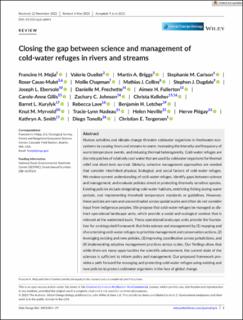Closing the gap between science and management of cold-water refuges in rivers and streams
| dc.contributor.author | Mejia, Francine H. | |
| dc.contributor.author | Ouelle, Valerie | |
| dc.contributor.author | Briggs, Martin A. | |
| dc.contributor.author | Carlson, Stephanie M. | |
| dc.contributor.author | Casas-Mulet, Roser | |
| dc.contributor.author | Chapman, Mollie | |
| dc.contributor.author | Collins, Mathias J. | |
| dc.contributor.author | Dugdale, Stephen J. | |
| dc.contributor.author | Ebersole, Joseph L. | |
| dc.contributor.author | Frechette, Danielle M. | |
| dc.contributor.author | Fullerton, Aimee H. | |
| dc.contributor.author | Gillis, Carole- Anne | |
| dc.contributor.author | Johnson, Zachary C. | |
| dc.contributor.author | Kelleher, Christa | |
| dc.contributor.author | Kurylyk, Barret L. | |
| dc.contributor.author | Lave, Rebecca | |
| dc.contributor.author | Letcher, Benjamin H. | |
| dc.contributor.author | Myrvold, Knut Marius | |
| dc.contributor.author | Nadeau, Tracie-Lynn | |
| dc.contributor.author | Neville, Helen | |
| dc.contributor.author | Piégay, Herve | |
| dc.contributor.author | Smith, Kathryn A. | |
| dc.contributor.author | Tonolla, Diego | |
| dc.contributor.author | Torgersen, Christian E. | |
| dc.date.accessioned | 2023-08-17T12:52:06Z | |
| dc.date.available | 2023-08-17T12:52:06Z | |
| dc.date.created | 2023-08-09T10:11:14Z | |
| dc.date.issued | 2023 | |
| dc.identifier.issn | 1354-1013 | |
| dc.identifier.uri | https://hdl.handle.net/11250/3084618 | |
| dc.description.abstract | Human activities and climate change threaten coldwater organisms in freshwater eco-systems by causing rivers and streams to warm, increasing the intensity and frequency of warm temperature events, and reducing thermal heterogeneity. Cold-water refuges are discrete patches of relatively cool water that are used by coldwater organisms for thermal relief and short-term survival. Globally, cohesive management approaches are needed that consider interlinked physical, biological, and social factors of cold-water refuges. We review current understanding of cold-water refuges, identify gaps between science and management, and evaluate policies aimed at protecting thermally sensitive species. Existing policies include designating cold-water habitats, restricting fishing during warm periods, and implementing threshold temperature standards or guidelines. However, these policies are rare and uncoordinated across spatial scales and often do not consider input from Indigenous peoples. We propose that cold-water refuges be managed as dis-tinct operational landscape units, which provide a social and ecological context that is relevant at the watershed scale. These operational landscape units provide the founda-tion for an integrated framework that links science and management by (1) mapping and characterizing cold-water refuges to prioritize management and conservation actions, (2) leveraging existing and new policies, (3) improving coordination across jurisdictions, and (4) implementing adaptive management practices across scales. Our findings show that while there are many opportunities for scientific advancement, the current state of the sciences is sufficient to inform policy and management. Our proposed framework pro-vides a path forward for managing and protecting cold-water refuges using existing and new policies to protect coldwater organisms in the face of global change. behavioral thermoregulation, climate change adaptation, lotic ecosystem management, refugia, salmonids, temperature, thermal heterogeneity, thermal refuges | en_US |
| dc.language.iso | eng | en_US |
| dc.rights | Navngivelse-Ikkekommersiell 4.0 Internasjonal | * |
| dc.rights.uri | http://creativecommons.org/licenses/by-nc/4.0/deed.no | * |
| dc.subject | Klimaendringer | en_US |
| dc.subject | Climate change | en_US |
| dc.subject | behavioral thermoregulation | en_US |
| dc.subject | climate change adaptation | en_US |
| dc.subject | lotic ecosystem management | en_US |
| dc.subject | refugia | en_US |
| dc.subject | salmonids | en_US |
| dc.subject | temperature | en_US |
| dc.subject | thermal heterogeneity | en_US |
| dc.subject | thermal refuges | en_US |
| dc.title | Closing the gap between science and management of cold-water refuges in rivers and streams | en_US |
| dc.title.alternative | Closing the gap between science and management of cold-water refuges in rivers and streams | en_US |
| dc.type | Peer reviewed | en_US |
| dc.type | Journal article | en_US |
| dc.description.version | publishedVersion | en_US |
| dc.rights.holder | © 2023 The Authors | en_US |
| dc.subject.nsi | VDP::Matematikk og Naturvitenskap: 400::Zoologiske og botaniske fag: 480 | en_US |
| dc.source.journal | Global Change Biology | en_US |
| dc.identifier.doi | 10.1111/gcb.16844 | |
| dc.identifier.cristin | 2165802 | |
| dc.relation.project | Andre: National Science Foundation DBI-1639145 (USA) | en_US |
| cristin.ispublished | true | |
| cristin.fulltext | original | |
| cristin.qualitycode | 2 |
Tilhørende fil(er)
Denne innførselen finnes i følgende samling(er)
-
Publikasjoner fra CRIStin - NINA [2364]
-
Scientific publications [1392]
Vitenskapelige artikler, kapitler og monografier i Open Access.

